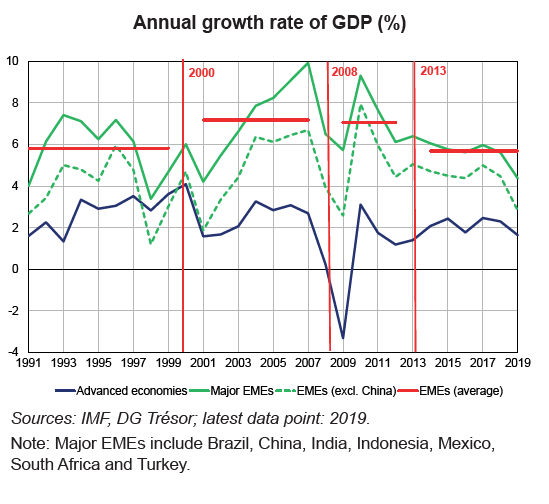The Structural Economic Slowdown in Major Emerging Market Economies
The generalised catching up of the advanced countries by the large emerging countries has stalled since 2013. This slowdown in activity is structural in most countries due to the weakening of the dynamics of the factors of production (labour, capital, total factor productivity), which determine their potential growth. However, all major emerging countries have room to increase their potential growth.
Major emerging market economies (EMEs) are seeing a slowdown in their catch-up with advanced economies. After averaging more than 7% from 2000 to 2007, the annual growth rate of major EMEs levelled off to 6.5% from 2008 to 2012 thanks to stimulus policies in the aftermath of the 2008 financial crisis. However, it subsequently fell to an average of about 5% from 2013 to 2019 (see Chart below).
This slowdown in economic activity is structural in most economies due to the declining dynamism of production factors (labour, capital, total factor productivity), which determine the growth potential of an economy. For nearly ten years, the slowdown has been especially pronounced in Brazil, China and South Africa. Only India and Indonesia, which are further behind in closing the gap with advanced economies, have been able to maintain high, relatively stable growth rates.
Labour is contributing less to growth due to population ageing and inadequate job creation. Capital accumulation through investment is also losing momentum. Productivity growth spurred by rural-to-urban migration (reconversion of agricultural workers to more productive sectors) and resulting from reforms undertaken in the 1990s and 2000s in most EMEs is petering out in Asia.
All EMEs have room to raise their potential growth. They can increase the contribution of labour to growth by expanding women’s participation in the labour market, and boost investment and productivity by improving education levels and further opening domestic markets.
The growth trajectory of major EMEs is exposed to a number of risks, such as the rebalancing of China’s economy, the reconfiguration of global value chains, the energy transition and the effects of climate change.
